You may be wondering what plants like acidic soil if you live in woodlands or other places where the soil is acidic. If you’ve tried growing different plants in acidic soil, you would have noticed that not all of them did well. There are 21 different types of plants that like acidic soil in this list including flowers, vegetables, and fruits.
Plants, depending on their species, often show a preference for either acidic or alkaline soils. While some plants like acidic soil and thrive in it, others simply tolerate it or perform better when grown in alkaline environments.
This is because the pH level of the soil can affect a plant’s ability to take up or utilize the nutrients available in the soil. Acidic soils have a pH that’s below 7, while alkaline soils have a pH higher than 7.
Slightly acidic soils make nutrients more accessible to plants. They also provide the right conditions for many soil-dwelling microbes to convert nitrogen into forms plants can use.
But be careful because soils that are too acidic can be toxic to some plants, including species that like slightly acidic soils.
Read on to learn what plants like acidic soil.
Table of Contents
Plants That Like Acidic Soil
Ornamental Plants, Trees, and Shrubs
These ornamental plants grow well in acidic environments and can help beautify your home or garden if your soil has a high acidity:
1. Japanese Camellia

- Difficulty Level: Beginner to Intermediate
- Family: Theaceae
- Scientific Name: Camellia japonica
- Other Names: Camellia, Common Camellia, Peony Camellia, Thea Japonica
The Japanese camellia is an evergreen garden shrub common in southern gardens in the United States. It is native to Asian countries such as China, Japan, and South Korea, from where it was imported into the US.
This plant is pretty long-lived. It can live more than a hundred years if kept well, but it takes some time to grow when first planted. It prefers shaded or partly shaded environments that aren’t too cold or too hot, otherwise it might not flower well.
Japanese camellias thrive in well-drained, slightly acidic soils with a pH between 5.5 and 6.5. They bloom flowers that may be white, pink, or red. Their leaves are usually green but may turn yellowish if the soil isn’t acidic enough.
Flowers may appear sometime in October and continue to bloom up to March in the following year. Flowers on camellia plants may last up to four weeks before being replaced by newer buds, attracting pollinators and songbirds while present.
2. Blue Ageratum
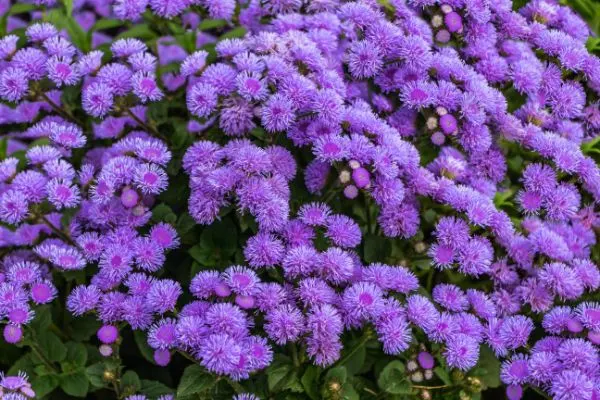
- Difficulty Level: Beginner
- Family: Asteraceae
- Scientific Name: Ageratum houstonianum
- Other Names: Ageratum, Floss Flower, Bluemink, Mexican Ageratum, Blue Billygoatweed
The blue ageratum is a small, delicate plant with aster-like flowers that are typically blue or lavender. However, you’ll also find varieties of this plant with white, pink, or purple flowers.
This annual plant is named after its ability to retain the colors of its flowers for long periods. It performs best in moist, well-drained, slightly acidic soils. However, it also does fine in neutral and slightly alkaline environments.
Blue ageratum is not shade-friendly and thrives in environments where it receives plenty of sunlight. For example, in the colder north, it needs full exposure to sunlight. It will still do well when placed in partial, but not full, shade in very sunny regions down south.
Ageratum flowers bloom from May to October and attract pollinators such as butterflies to your garden.
3. Bunchberry
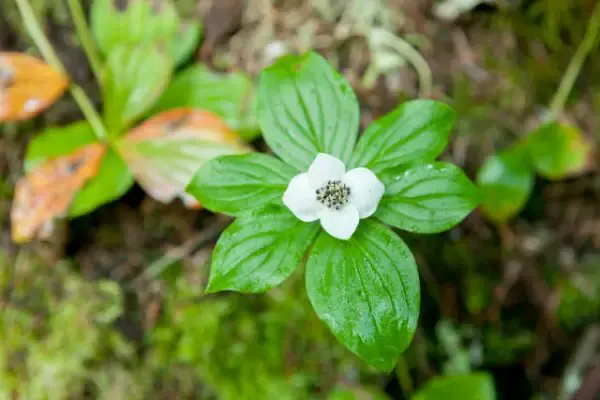
- Difficulty Level: Intermediate
- Family: Cornaceae
- Scientific Name: Cornus canadensis
- Other Names: Canadian Bunchberry, Bunchberry Dogwood, Canadian Dwarf Cornel, Dwarf Dogwood
Bunchberries are modest plants with green leaves and small, four-petalled, white flowers. These perennial plants are often used as ground cover in moist woodland gardens.
Bunchberry grows best in organically rich, slightly acidic, well-drained soils with moderate moisture. It also enjoys cool climates and partially shaded environments with just enough sunlight exposure.
Bunchberries produce small drupes that ripen in August and remain attached for long periods unless consumed by birds. These drupes are safe for humans to consume.
Although these plants can be difficult to establish, they are easy to care for once established. They are pretty low-maintenance and aren’t especially vulnerable to most diseases and insect attacks. In fact, they are quite resistant to dogwood anthracnose.
4. Begonia
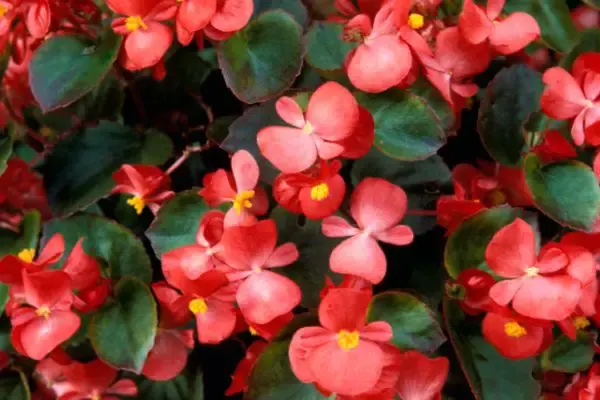
- Difficulty Level: Intermediate
- Family: Begoniaceae
- Scientific Name: Begonia spp.
- Other Names: Wax Begonia, Angel Wing Begonia, Painted-Leaf Begonia
Begonias are sweet-smelling perennial flowers that come in various vibrant shades of pink, red, white, and yellow or gold. These flowers are cultivated for many reasons and make good indoor or front porch plants because of their nice, peach-like scent.
Begonia is a diverse genus of flowers with nearly 2,000 species. It grows well within a wide pH range, but you’ll get the best result if you grow it in an acidic soil with a pH between 5.2 and 6.0.
This plant thrives in moist, well-drained soil with indirect exposure to sunlight. Although its vibrant color and sweet scent makes it suitable for indoor cultivation, it may be toxic to pets that eat them. It’s best to keep the plant out of reach.
5. Azalea
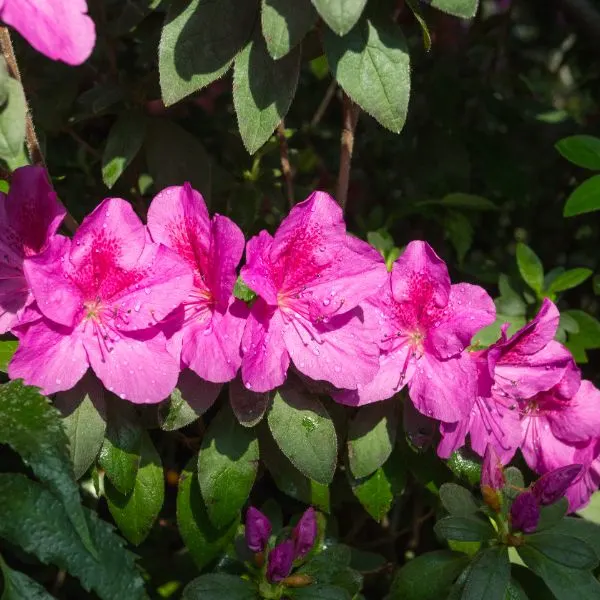
- Difficulty Level: Intermediate
- Family: Ericaceae
- Scientific Name: Rhododendron sect. Tsutsusi
- Other Names: Rhododendron
Azaleas are a group of plants with vibrantly coloured flowers that may be small shrubs or grow into tree-sized plants. The flowers come in diverse colors but are usually pink, bell-shaped, and fragrant.
Azaleas are acid-loving plants that grow best in well-drained soils where the pH sits between 5.2 and 6.0. The plants enjoy partial shade and relatively humid environments, where they typically bloom in spring.
There are several types of azaleas, but they fall into two groups: evergreen or deciduous azalea. Evergreen azaleas retain their green leaves throughout the year, while deciduous azaleas lose their leaves in winter.
6. Gardenia

- Difficulty Level: Advanced
- Family: Apiaceae
- Scientific Name: Gardenia jasminoides
- Other Names: Cape Jasmine, Common Gardenia
Gardenias are stunning white or milk-white flowers that are often grown in the southern parts of the US because of their preference for humid environments. These plants are sensitive to cool temperatures and can be difficult to grow.
Even when established, these fine shrubs require plenty of maintenance to stay fit. But the reward of growing them, if you can do the work, is a beautiful, sweet-scented landscape.
Gardenias need full to partial sunlight to grow well, which is why they perform better in the south. They also have a preference for slightly acidic environments where the pH is between 5 and 6.5.
7. Caladium
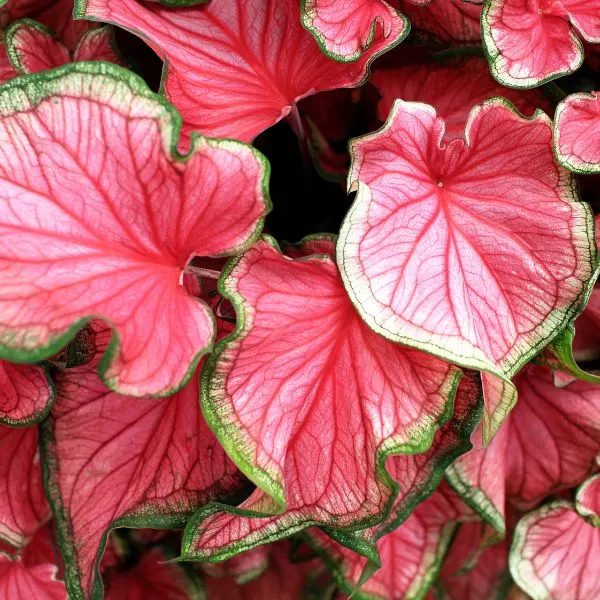
- Difficulty Level: Beginner to Intermediate
- Family: Araceae
- Scientific Name: Caladium bicolor
- Other Names: Angel Wings, Elephant Ear, Heart of Jesus
At first glance, caladium leaves might seem to be deficient in something. A second glass will quickly prove this assumption wrong, revealing instead a stunning pattern of pink, white, and bleached green streaks.
The vibrantly colored patterns on caladium leaves makes it a suitable ornamental plant for many gardens and shaded compounds. Since its patterns are on its leaves, it may be used as a substitute for flowering plants with long wait periods between blooms.
This plant is originally native to the tropical regions of South America, where it grows as a perennial plant. However, it grows as an annual plant in cooler climates.
As a tropical plant, caladium requires warm, humid conditions to grow well. However, it prefers indirect exposure to sunlight. You can cultivate it using filtered light or keep it in partial shade since direct sunlight exposure can damage its leaves.
Caladium grows best in humus-rich, well-drained, acidic soils where the pH is between 6 and 6.5.
8. Heather
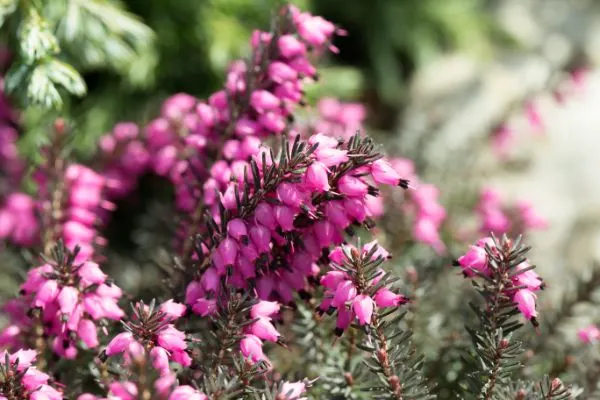
- Difficulty Level: Beginner
- Family: Ericaceae
- Scientific Name: Calluna vulgaris
- Other Names: Calluna Heather, Common Heather, Ling
Also called the common heather, this plant is a hardy, low-growing evergreen shrub from the same family as blueberries. There are over 500 varieties of heathers you can grow in your garden, but they are all cultivars of this species.
Heathers are acid-loving plants that thrive in moderate to highly acidic soils with pH as low as 4.5. The sweet spot for optimum growth is between 4.5 and 5.5. While heathers will survive in neutral or slightly alkaline environments, they won’t grow as well.
There are many reasons to plant heathers in your garden. This plant isn’t only useful as an ornamental plant with colorful flowers that’ll beautify your garden. It is wonderful at suffocating weeds and stunting their development.
Heathers typically bloom in late summer or early fall, but this isn’t true for all varieties. Its flowers attract bees and other pollinators, which can be beneficial for other plants in your garden
Herbs and Veggies That Like Acidic Soil
Countless herbs and vegetables thrive in acidic environments. Some of them include:
9. Rhubarb

- Difficulty Level: Beginner to Intermediate
- Family: Polygonaceae
- Scientific Name: Rheum rhabarbarum
- Other Names: Pieplant
Rhubarb is a delicious vegetable that’s a staple in many types of desserts. This perennial plant is easy to grow, and it thrives in soils with slight to moderate acid contents. A pH of 5.5 to 6.8 is ideal for this vegetable’s development.
There are several varieties of rhubarb, but most of them have pink to reddish edible stalks with ample amounts of sweet juice. Since this plant is perennial, you can continue to enjoy its benefits many years after planting.
However, you should leave your rhubarb for a year or two after planting before you start actively harvesting it. This ensures that the plant has developed enough resilience to support periodic harvesting.
10. Parsnips
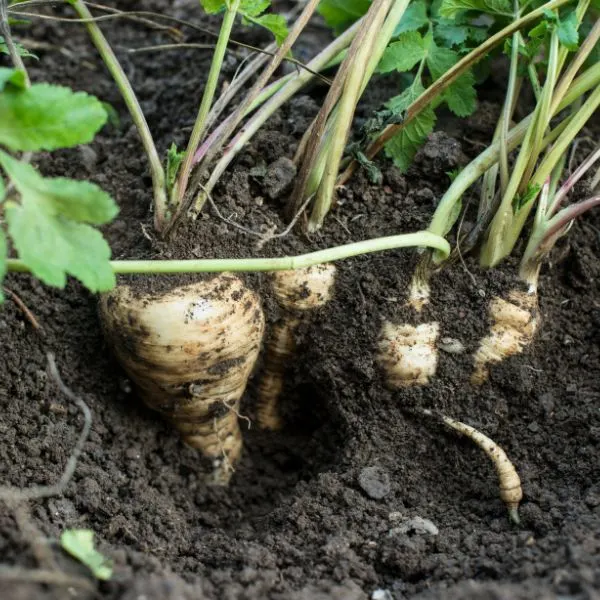
- Difficulty Level: Beginner
- Family: Apiaceae
- Scientific Name: Pastinaca sativa
- Other Names: N/A
Parsnips are tasty, biennial root vegetables that are often cultivated for use as cooking items. Like many root crops, parsnips have a long, slender shape with a tapering end that’s similar to those of carrots. Unlike carrots, its body is cream-colored.
These plants thrive in well-aerated soils that are slightly acidic. The ideal pH to grow these veggies is between 6.0 and 6.8. Since these are root crops, ensure the soil you’re planting them in is free of obstacles that could interfere with their growth.
Parsnips thrive under cool environmental setups and are best planted in spring or towards the end of summer.
11. Carrots

- Difficulty Level: Intermediate
- Family: Apiaceae
- Scientific Name: Daucus carota
- Other Names: Danvers Carrot
Carrots, like parsnips, are biennial root vegetables with a long, slender body that tapers off into a pointed end. Its body is typically orange, but less common yellow, red, purple, and white varieties are also cultivated.
Carrots will grow well if you plant them in well-drained soils that are slightly acidic, but they also grow just as well in neutral soils. Though they grow underground, they need adequate lighting for optimal development.
Similar to parsnips, carrots are often cultivated for human consumption. They may be eaten uncooked or used to garnish dishes when cooking because of their taste, crunchiness, and richness in nutrients.
12. Radish

- Difficulty Level: Beginner
- Family: Brassicaceae
- Scientific Name: Raphanus sativus
- Other Names: Daikon
Radish is a small, reddish root vegetable that likes acidic soil. It’s a fast-growing plant that doesn’t take up much real estate. It takes only about 45 days for it to fully develop into a harvest-ready form.
Radish grows in cool environments and is often planted in spring or fall. This vegetable performs best in well-drained soil with a slightly acidic pH. Although there are various types of radishes, most will thrive in media with a pH around 6.5.
The size of radish varies with the type. Its root is the edible part, which is often used as an ingredient in many salads because of its crispness and peppery taste.
13. Broccoli
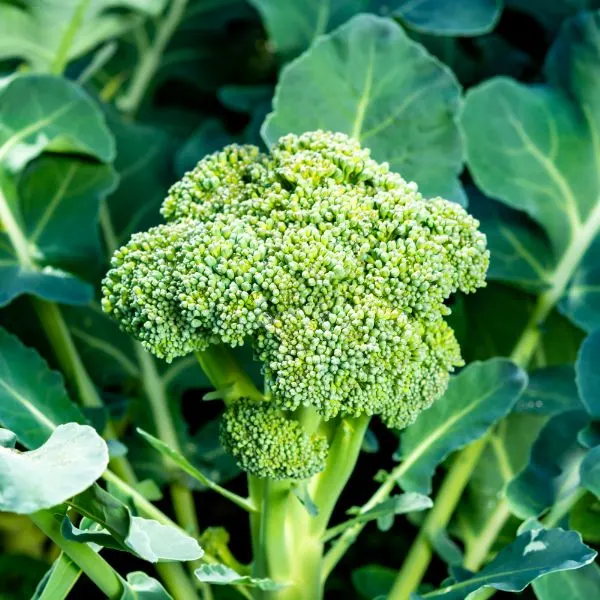
- Difficulty Level: Beginner
- Family: Brassicaceae
- Scientific Name: Brassica oleracea
- Other Names: Ornamental Cabbage
The broccoli plant can grow up to three feet in height, and it thrives in cool to moderate climates. The plant is composed of a thick, edible stem on which clusters of green flower buds (called “florets”) or leaves grow.
Broccoli belongs to the same family as cabbages and is cultivated for its edible leaves. This vegetable is a source of many essential vitamins and minerals, so it’s a common ingredient in several culinary recipes.
You can grow broccoli in partial shade, but it’s best grown in full sunniness. It requires consistent moisture in a well-drained soil rich in organic matter. Although it also grows in alkaline environments, it prefers slightly acidic soil with a pH between 6 and 6.8.
14. Beans
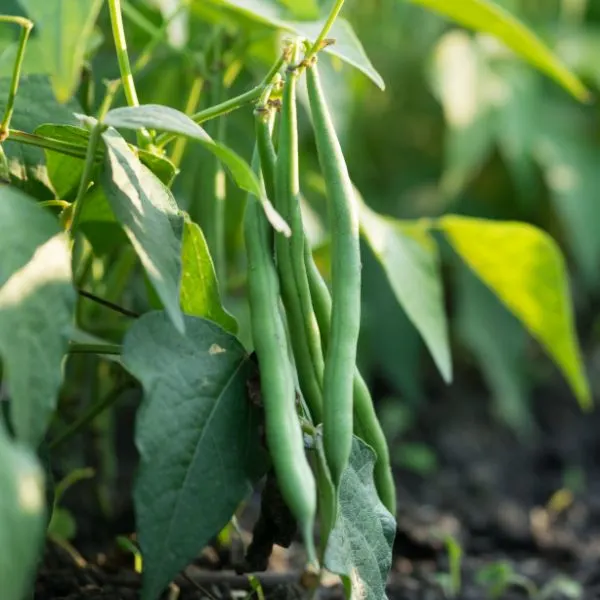
- Difficulty Level: Beginner
- Family: Fabaceae
- Scientific Name: Phaseolus vulgaris
- Other Names: Common Bean, French Bean, Haricot Bean, Salad Bean, Snap Bean, String Bean
Beans are leguminous plants that may be grown as annuals or perennials, depending on the variety you choose to grow. There are many bean varieties that you can grow for different purposes.
The common bean is often grown to be used as snap or dry beans. This bean likes soils that are slightly acidic, with most thriving at any pH between 6 and 6.8. This pH range is also suitable for other types of beans.
Beans are easy to grow in well-drained soil. They require full exposure to sunlight if you want them to turn out well. Since these leguminous plants also fix nitrogen in the soil, they are beneficial companion plants to other crops you might have in your garden.
15. Sweet Potato
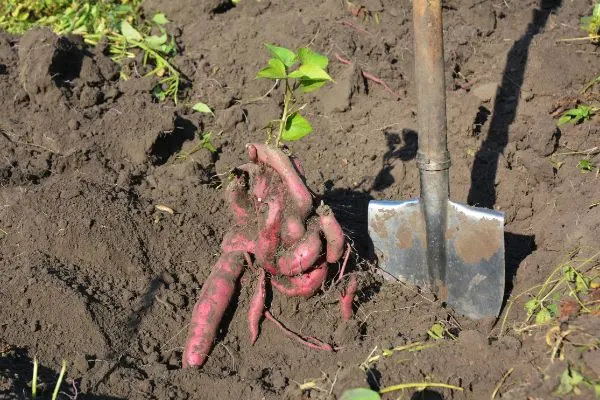
- Difficulty Level: Beginner
- Family: Convolvulaceae
- Scientific Name: Ipomoea batatas
- Other Names: Potato
Sweet potatoes are native to Central and South America. These delicious root crops are widely cultivated around the world, where they serve various culinary purposes because of their sweet taste and high nutritional value.
This sweet crop is typically yellow or whitish, but there are a host of cultivars with orange and purple skins. It thrives in well-drained, loose, sandy loam soils with slightly acidic pH. The pH range for optimal growth is 5.5 to 6.5.
The sweet potato plant is a hardy perennial crop that is resistant to drought. Above ground, the plant grows in the form of trailing vines dotted with sweet-smelling purple flowers. It belongs to the same family as the morning glory.
16. Onions
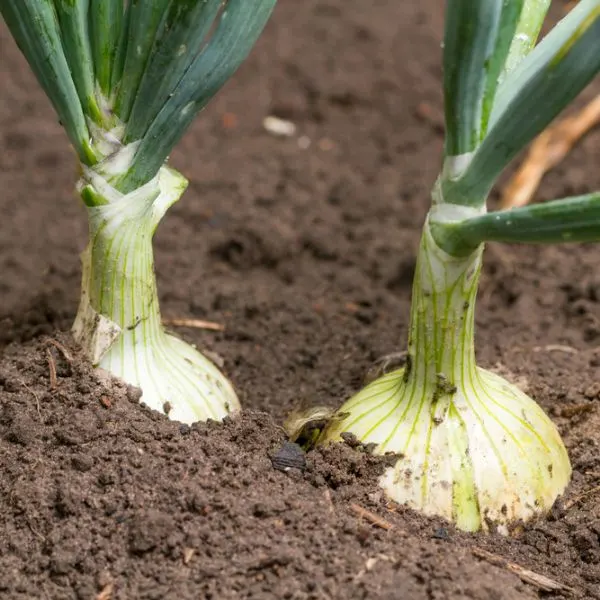
- Difficulty Level: Beginner
- Family: Amaryllidaceae
- Scientific Name: Allium cepa
- Other Names: Bulb Onion, Spring Onion, Shallot
Onions are rich in vitamins, minerals, and antioxidants with potential benefits for your cardiovascular and digestive systems. Sadly, the smell and taste of onion isn’t for everyone. But if you like this vegetable, you can easily grow it in your garden.
There are many varieties of onions to choose from, each modified to appeal to people of different tastes. Yellow onions tend to have a more pungent smell and taste, but red and white onions are milder and sweeter in comparison.
Onions grow well in neutral soil, but they prefer slightly acidic soils where the pH is between 6 and 7 for the best results. These veggies thrive in well-drained soils that are very rich in organic matter and subject to full sunlight exposure.
Fruits to Grow in Acidic Soil
Here are some fruits that do well in soils with high acidity:
17. Blueberries

- Difficulty Level: Beginner
- Family: Ericaceae
- Scientific Name: Vaccinium sect. Cyanococcus
- Other Names: Highbush Blueberry, Lowbush Blueberry, Bilberry
Blueberry may refer to the small, delicious fruit or the blueberry shrub on which the fruit grows. The blueberry shrub is a perennial, acid-loving plant that thrives in acidic environments where the pH ranges between 5 and 6.
There are many varieties of blueberries, and each has its own requirements for cultivation. However, most blueberries grow well under full or partial exposure to sunlight. They also tend to bloom in spring or summer.
If you’re at a loss regarding what to plant in the acidic soil in your garden, consider growing blueberries there. The fruits are prized for their delicious taste and richness in important antioxidants.
Blueberry plants are quite low-maintenance, although regular watering and pruning are essential to keep the plant in good health.
18. Apples
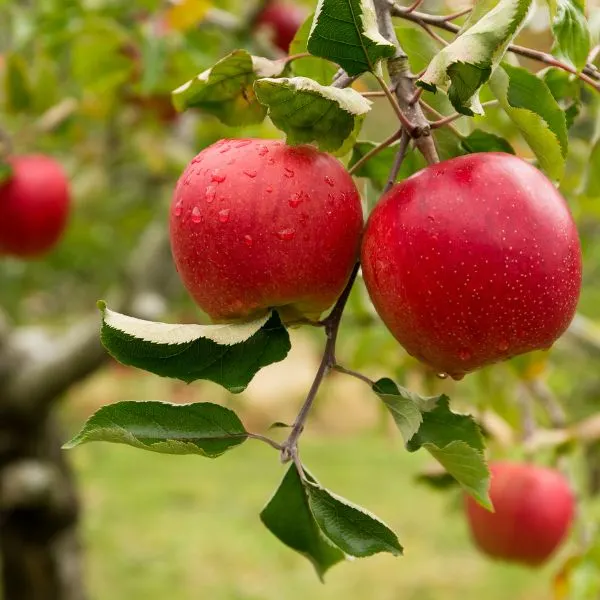
- Difficulty Level: Advanced
- Family: Rosaceae
- Scientific Name: Malus domestica
- Other Names: Common Apple
Apples are among the most highly consumed fruits in the world because of their distinctly delicious flesh and their crunchiness when eaten. There are several apple cultivars worldwide, with many selectively bred to enhance different tastes and qualities.
These plants are best grown in temperate regions, but adjustments can be made to help them thrive in warmer climates. Apples have a preference for soils where the pH ranges from a near-neutral 6.8 to a slightly acidic 5.5.
Apples come in various colors, but the most common are red, orange, yellow, and green. They are packed with many nutrients, essential minerals, and antioxidants. These fruits are also low in calories and rich in fiber.
Although an apple tree would be a nice addition to your garden, know that it’ll likely take a few years before your efforts yield tangible results. You’ll also need to closely tend to the plant after sowing it to ensure it develops well.
19. Tomato

- Difficulty Level: Beginner to Intermediate
- Family: Solanaceae
- Scientific Name: Solanum lycopersicum
- Other Names: Beefsteak Tomato, Cherry Tomato
Tomato is an acid-loving plant that grows best in well-drained soil where the soil pH is between 6.2 and 6.8. However, it can tolerate acidic soils where the pH is as low as 5.5.
This perennial plant is originally native to the tropics of South America, and it does best when grown under full exposure to sunlight.
In most parts of the US, tomatoes are grown as annual crops. There are many varieties to choose from if you decide to plant this crop in your garden. The crop is easy to grow, but applying excess nitrogen can lead to vibrant leaves with little fruit production.
The classification of tomatoes is a slightly controversial issue. A botanist (who is right, by the way) will likely tell you it’s a fruit, although a nutritionist will insist it’s a vegetable. Its classification as a veggie is due to its frequent use in the preparation of many dishes.
20. Raspberries
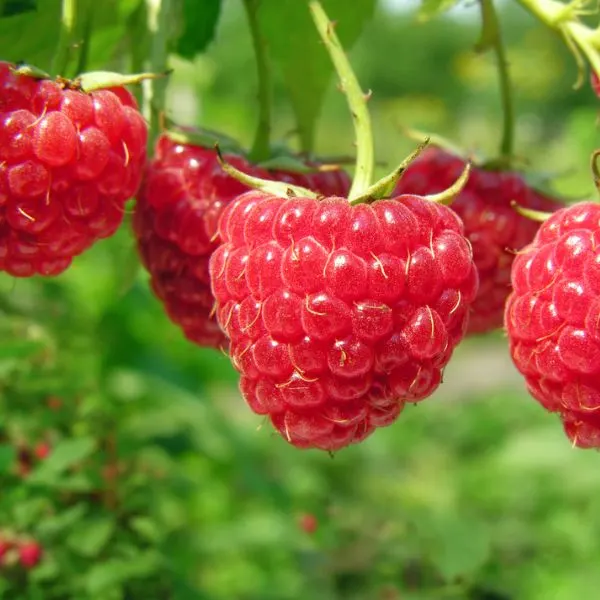
- Difficulty Level: Beginner
- Family: Rosaceae
- Scientific Name: Rubus idaeus
- Other Names: Red Raspberry, Black Raspberry
Raspberries like acidic soil where the pH is between 5.5 and 6.5. They can tolerate pH slightly beyond this range. But if your soil is too acidic, consider using lime to dilute it up to a year before planting your raspberries.
Make sure to grow raspberries in well-drained, sandy loam soil that’s high in organic content. The plants require about eight hours of sunlight every day for optimum development.
Most raspberries are red, but there are other varieties to choose from when planting. You could go for black raspberries, which taste a bit different from red raspberries or go for purple raspberries. Purple raspberries are hybrids of red and black raspberries.
21. Grapes
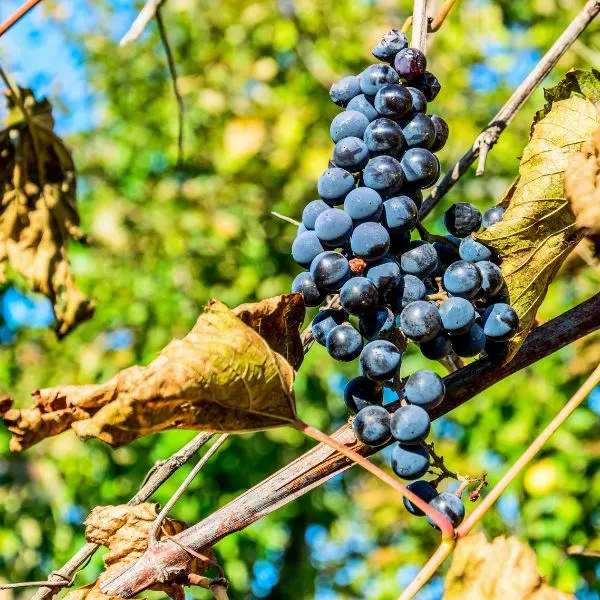
- Difficulty Level: Intermediate
- Family: Vitaceae
- Scientific Name: Vitis vinifera
- Other Names: Vineyard Fruit, Wineberry
Grapes grow best in soil where the pH is between 5.5 and 6.5. Although you can grow grapes in highly acidic environments where the pH reaches 4, your plant will struggle. You’d also be forgoing good fruit yield.
Grape vines are climbers that require support structures. The soil you plant them in has to be well-drained, and they need enough water and sunlight exposure for proper growth. So don’t hide them in full shades.
This plant has been cultivated for thousands of years, so there are nearly countless cultivars to choose from. You can plant seeded or seedless grapes, or choose varieties bred for specific purposes like winemaking or direct consumption.
Grapes come in purple, green, red, pink, and black colors. Though practices may vary between the types, most grapes will be ready for harvest in fall or late summer.
Frequently Asked Questions
If you still have questions about what plants like acidic soil, check out our answers to questions readers like you often ask.
What are plants that like acidic soils called?
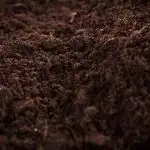
Plants that thrive in acidic environments are known as oxylophytes. You may also see them referred to as oxyphytes or oxalophytes.
Some oxylophytes prefer acidic soils but perform reasonably well in neutral or slightly alkaline soils. However, some are restricted to acidic soils and perform poorly elsewhere.
Is acidic soil good for crops?

Yes, slightly acidic soil is good for certain crops because it makes nutrients more accessible and provides a conducive environment for the survival of beneficial soil organisms.
However, if the acid content is too high, it can cause microbial activities in the soil to shut down and lead to the release of compounds like molybdenum in toxic concentrations. Some crops also perform better in non-acidic environments.
Do palm trees like acidic soil?

Yes, palm trees like acidic soil. These giants favor slightly acidic environments where the pH is between 5.5 and 7.5, but 6.3 is the optimum pH for their growth.
Does corn like acidic soil?
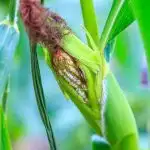
Yes, corn does well in acidic soil. But it’s best when kept in slightly acidic soil with a pH between 6 and 6.5. If the soil is more acidic than this, it can impair the plant’s development.
Do vegetables like acidic soil?

It depends on the vegetable in question. Some vegetables prefer acidic soil, while others prefer more slightly alkaline or neutral environments. Most vegetables, however, can thrive in acidic soils where the pH is as low as 5.5.
Do beans grow in acidic soil?
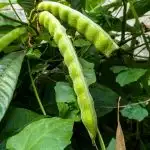
Yes, beans thrive in acidic soil. But they prefer it when the soil is only slightly acidic. They don’t grow as well where the pH is below 6.0, so ensure your soil isn’t too acidic for them.
Do cucumbers like acidic soil?
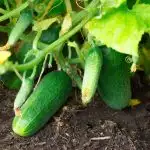
Yes, cucumbers like soil that is slightly acidic. They grow best in an environment where the pH is between 6 and 6.5.
Do tomatoes like acidic soil?

Yes, tomatoes like acidic soil. These acid-loving plants thrive in mildly acidic environments, but not highly acidic ones.
Does cabbage like acidic soil?
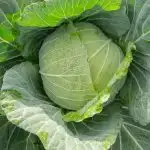
Yes. Cabbage belongs to the same family as broccoli and does well in mildly acidic media. The optimum soil pH for cabbage growth is between 6 and 7.
Do carrots grow in acidic soil?

Yes, carrots and other root vegetables like it grow well in acidic soil. They perform best when the soil isn’t highly acidic.
How can I change my soil acidity?

Most acid-loving plants have a preference for slightly acidic soil over highly acidic ones. If your soil is too acidic to support plant growth, you can make it less acidic by mixing in some lime, compost mix, or wood ash. This process is known as soil alkalization.
If you’d like to make your neutral or alkaline soil more acidic, commonly recommended options include the use of peat moss, pine needles, or sulfur. More short-term options include the addition of vinegar.
Make sure you take the pH of the soil beforehand. You should also read guides that tell you how much alkalizing or acidifying agents you need to get the level of acidity you desire.
Conclusion
We’ve discussed over 20 different types of plants that do well in acidic soil. In the real world, the number of acid-loving plants you can grow in your garden is virtually unlimited.
We hope this list gives you an idea of what to plant in your acidic soil. But it’s more important to think about what you want out of your space, not just about what plants like acidic soil.
Knowing whether or not a plant you’re interested in likes acidic soil is only half the question. Be sure its ideal pH range matches that of your soil. Also consider its other maintenance requirements and whether or not you can commit to seeing it bloom.
Guide On Companion Plants
